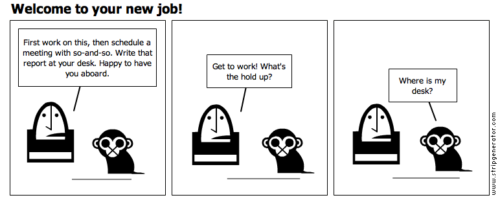Every small business leader wants to get the most out of new team members as fast as possible, while keeping current employees as long as possible. If that is the case, then why do so many companies not have a formalized employee onboarding process?
Researchers have found that the new hire onboarding process is a point in the employee life cycle that has a tremendous impact on the long-term success of employees. As a matter of fact, many of your employees know in the first ten days if they will be looking for work in the next 18 months.
Most organizations find it challenging to stick with an onboarding program. You will often hear excuses such as “we’re too busy” and “we tried, but it didn’t stick.”
Here are all of the resources and guidance you will need to create an employee onboarding program that you can put on auto-pilot and will have a big impact down the road.
Sound good?
What is employee onboarding?
Onboarding, also known as organizational socialization, refers to the mechanism through which new employees acquire the necessary knowledge, skills, and behaviors to become effective organizational members and insiders.
It has been proven, across large cross-sections of industries, that a formalized new hire onboarding process has an impact not only on employee performance, but also on employee retention and engagement levels.
What impact does employee onboarding have on my business?
Employee’s attitudes and experiences when joining a new company shape how productive they are at work and how long they will stay with an employer. First impressions make a difference.
Employee turnover is costly for employers and the commitment level of employees to the organization can greatly impact profitability. Being able to more effectively onboard and assimilate team members has proven to decrease turnover.

If an organization has high turnover and does nothing to solve the issue, the repercussions could be very expensive. (up to twice an employee’s annual salary) Constantly replacing employees, poor morale amongst your team, and high training costs will cost you as you continually bring on new employees.
All of these outcomes would do one thing: decrease profitability.
You are trying to remain competitive and that takes top talent. When your employees are constantly changing, it becomes difficult to get ahead of the competition.
Is there a solution?
The effect of employee turnover on your business can be catastrophic. Therefore, it is imperative to focus your efforts on retaining top talent.
Decreased turnover will result from new employees becoming a member of the “team” earlier. There is not one right way guaranteed to decrease turnover, but there are several strategies that have been proven to have a positive effect on the desired outcome.
By implementing a formalized employee onboarding process, you can expect to see a decrease in turnover and an increase in employee engagement.
Combine a formalized process with the right technology and you have a solid framework for reducing employee turnover and making your people more productive, faster.
Why is onboarding the key?
The new hire onboarding process has been proven to have a direct correlation to each of the aforementioned performance indicators. Companies that have formalized onboarding processes see a 60% year-over-year improvement in productivity versus those that do not have a formalized onboarding process.
The new hire onboarding process is critical as it provides a first impression of the organization to the new hire. New hire onboarding provides an opportunity to develop a relationship that can either be highly productive and engaged or “just another job.”
This relationship may enhance employees’ commitment levels which are important and should be established early on through proper new hire processes.
The formalization of assimilation and socialization of new hires as part of the onboarding process has proven to increase the speed at which these employees achieve performance milestones.
Companies that have more progressive human resources (HR) practices such as mentorship programs and assimilation measurement should expect to see a higher operational performance from the organization.
Higher operational performance is a result of the employees feeling more “at home” in their work environment and this comfort produces greater employee output.
Research and experience point to one key event in the life of a new hire that impacts all of the aforementioned issues: the new hire onboarding process.
The impact of a properly conducted and formal new hire onboarding process impacts engagement, retention, and productivity. If you would like the full version of the guide that walks you through every step from pre-hire, to six months in, you can download the Ultimate Employee Onboarding Guide here.
Please share your employee onboarding best practices in the comments. Thanks for reading!





